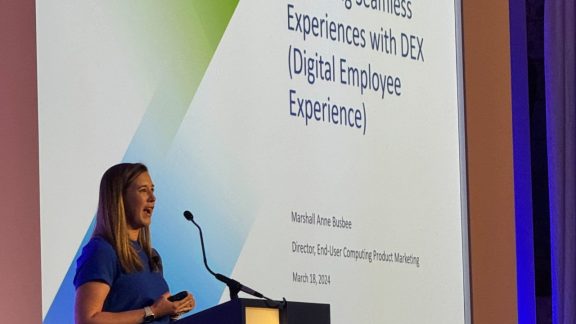By Noah Wasmer, VP of Product Strategy, End-User Computing, VMware
Without a doubt, 2014 has left an indelible impression on the technology landscape. Every major software and hardware player, including VMware, has continued to drive towards mobile and cloud for end-user computing. Before diving into the future predictions for 2015, let’s reflect on 2014 innovations as a basis of what’s to come.
In exploring the end-user computing landscape, one would be remiss to not explore the platforms that dominate our everyday computing experiences – namely Apple, Google and Microsoft.
- Apple –Apple has not been shy about expanding into the enterprise, announcing a new strategic partnership with IBM and offering new business applications targeting vertical markets to support business mobility. New features were also introduced that enabled content to be easily shared between applications and Apple devices (PCs, laptops, tablets, and smartphones), which further support mobile workforces. Lastly, rumors about an impending Apple iWatch were proven true – validating that the Internet of Things is more than just a buzz word and very much has enterprise implications down the road for IT administrators to consider.
- Google –Likewise, Google is interested in enterprise penetration and is leading with its own cloud services and applications. Innovative new offerings such as Google Now showed the ability of cloud services to have a real significant impact on our personal and professional lives, and allowed us to imagine life supported by predictive cloud analytics. New business capabilities in Android Lollipop helped make Android devices more enterprise-ready by working with EMM solutions such as AirWatch to secure Android apps, email, calendar, and content. In short, Google sees that growth will come from its cloud services and is working to get its foot in the elusive enterprise door by showing that it can support various aspects of business in an attempt to build credibility.
- Microsoft –Microsoft is certainly the strongest enterprise player among the three vendors but 2014 saw the company begin to embrace the post-PC era with greater investments in mobile computing. New cloud services with APIs for Office 365 and OneDrive were launched to support business mobility and Microsoft doubled-down on their mobile hardware efforts with the Surface Pro 3, new Windows smartphones, and a fitness wearable called Microsoft Band. It was evident that Microsoft knew it needed to pivot away from the PC platform in order to remain relevant and it demonstrated its commitment to change by delivering tangible cloud offerings and mobile solutions.
Across all three companies, there is a consistent pattern of hardware devices with tightly integrated software in which the operating system is increasingly immutable and hardened to provide a new level of security and management. On top of these platforms, developers are building rich native apps that tie into the near infinite compute and storage capability of the cloud. This separation between local experience and cloud computing allows users to have a high performing user experience with the real-time computing power benefits of the cloud – all on a phone or tablet!
What to Expect in 2015
Given the evolution and strides made by the three major computing platforms, application development and cloud computing in 2014, I predict business mobility to be a major focus not only for VMware but for the entire industry. Specifically, I anticipate a few key trends to surface next year.
- Cross Platform Support Will Become A Mandatory Capability Expected From End-User Computing Solutions. Authorized and unauthorized BYO workplaces continue to present challenges to IT departments as employees use devices and platforms of their choice to conduct business. As a result, businesses must look to secure mission critical apps and data across these diverse platforms that users love. VMware expects this trend to continue for years to come so the company acquired AirWatch in 2014 to secure and manage the next generation of devices, apps and content across modern platforms. We also launched Horizon 6 that delivers mission critical Windows desktops and applications to any device – including support for HTML remoting with 3D graphics capabilities. In 2015, customers can expect cross platform support to be VMware’s focus in business mobility with VMware Workspace Suite leading the way
- Big Data and Cloud Analytics Will Make Mobile Enterprise Applications Smarter. Consumer apps continue to reinvent our personal lives – providing us intuitive, fast user experiences that can leverage massive amounts of data in the cloud to produce valuable insights. As an example, Google Now can correlate a user’s location, time and typical routine and determine if one should leave earlier due to increased traffic. Businesses have begun to apply these technologies to business processes, and in 2015, I predict increased investments to combine big data analytics meshed with existing enterprise data. From the operating room to the board room, new enterprise apps will leverage big data analytics and mission critical application data such as CRM, ERP and EMR to provide new insights directly to a user’s device. Connected machines (such as vending machines, hospital and manufacturing equipment) will report real-time data into business processes to give a more holistic business perspectives. I anticipate enterprises will increasingly come to realize that a software-defined network becomes a requirement to dynamically secure access to this rich data – driving innovation solutions on platforms such as VMware NSX for network security and AirWatch for the endpoint.
- EMM Will Be Used To Manage Enterprise Desktops and Laptops. Today, managing enterprise desktops requires complex management software with painstaking processes for administrators – such as writing scripts for complex application installations. Unfortunately, this management model also does not effectively account for any changes to device, and in fact, was built on a model of “locking the device down” as a security measure. This lead to frequent help desk calls and more importantly, employee productivity loss as they look to leverage new apps and services to get their jobs done. In contrast, mobile devices looked at this process differently – with inherent security built into the OS that allowed users to install personal apps, but also secure and manage business apps and data. While iOS introduced this MDM model to the masses, the same primitives to secure the device, apps and content can now be found in nearly every operating system – from iOS, Android, Mac OS X, and the latest versions of Windows (8.1 and 10 preview). In 2015, I anticipate that we will see enterprises increasingly applying the EMM paradigm to desktops, laptops and mobile devices to account for changing BYOD and BYOC policies, as well as a growing demand to provide dynamic management based on the ever changing security of the device.
- Better Security and Lower Cost Will Drive More Cloud Adoption. Mission critical apps and data run in the data center, and IT is under increasing pressure to deliver these services to users with better security and at lower costs. Next year, the industry will see more organizations move their infrastructure to the cloud using solutions like VMware vCloud Air and VMware Horizon Air to lower operational costs and improve resiliency options. Since enterprises can maintain their business processes and security in the cloud, I see increased opportunities to transition to the cloud for even the most important applications.
- The Continued Modernization of the Windows Desktop. Virtualization continues to grow its value and reach for end-user computing. Many of the perceived challenges of virtual desktops continue to fall away with dramatically lower costs due to innovations in storage and management. Virtual environments continue to deliver on the “instant delivery” of end-user expectations even when dealing with complex Windows apps. To make Windows apps truly self-service, app virtualization provided great promise, as long as you could “re-package” your app successfully. With the acquisition of Cloud Volumes (now called App Volumes) VMware is working to merge these two ideals with simple packaging and instant deployment. As BYO continues to grow beyond mobile phones and tablets to the computer, technologies like VMware Horizon FLEX are providing a strong capability to run a corporate desktop image on a non-corporate computer – across both Windows and Mac. In 2015, VMware will continue to reshape how IT enables a more secure and efficient workplace – and help put focus where it belongs – on enabling employees to thrive in a modern business environment.
I truly believe 2015 is going to be an exciting year. VMware End-User Computing will be focused on helping customers respond to the changing business environment and embrace business mobility where mission critical apps and content are securely delivered to the employee’s device of choice. The rapid pace of innovation introduced to the product portfolio in 2014 helped VMware gain recognition as the leader in virtual desktops and EMM in 2014. This puts the company in a very strong position to address the macro trends it anticipates and I look forward to working closely with our partners and customers this coming year.






